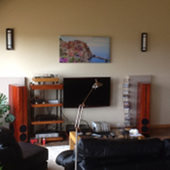General FAQs
Q: What is the shipping transit time for my order?
A: Most of our products are shipped via FedEx Ground. Our site will show you the FedEx Ground transit map on the shopping cart screen (when you enter a zip code to estimate shipping) and during the checkout process below the list of shipping method choices.
Shipping transit time is the number of business days your order will take to reach you after shipping from our facility. If you are shipping to a residence, you may also receive delivery via FedEx Home Delivery on a weekend day. For build-to-order products, please allow additional days for production prior to shipping. All products on our site outside of the "DIY Acoustic Materials" category are build-to-order products.
Transit times are based on standard business days (Monday through Friday). If you receive your shipping confirmation email after 3pm Central Time, your order's time in transit may begin the following day. Standard Overnight shipments sent on Friday will not arrive at their location until Monday. Saturday deliveries may be possible subject to your location's weekend delivery services. Contact one of our sales representatives to check if your area offers Saturday delivery services.
Q: When will my order ship?
A: Production times for orders vary based on the product and quantity being manufactured. Typical production times are listed under each product page. However, production backlogs or large quantity orders may increase these production timelines. If your order must arrive by a specific date, please contact us by phone, email, or chat to consult a sales representative for current production times or expedited/rush options.
Q: Should I pay for Rush Production on my order?
A: If you would like to receive your order by a specific date, you may wish to add Rush Production to your order. When you select the Rush option, a representative from our sales team will contact you with an expected ship date in about 1 business day. Rush Production expedites your order and moves it toward the top of our production lists. However, other customers who have previously paid for the same service may still be in line ahead of you. Depending on the number of orders already in line and your order's specifications, Rush Production may expedite your order anywhere from a couple days to a couple weeks. Rush Production is subject to the minimum time frames that it takes to manufacture specific products. In cases where production has a low backlog, your order may ship out before the typical production time. For the most up-to-date information, you can always contact us by phone, email, or chat to see if paying for Rush Production is the best option for you.
Sound Absorption and Acoustical Panel FAQ's
Q: How many acoustic panels do I need in my room?
A: Our online room acoustics analysis is a great tool to find the right answer for any room. You provide some information about the room dimensions and surfaces, and our system crunches the numbers for you.
Q: Where should I place the panels in the room?
A: In general, where you place the panels in the room is not critical. A visually pleasant appearance is often the guiding factor in placement. The most important thing is simply to get the total square footage of panels into the room somewhere. No matter where you place them, the panels will soak up the extra sound that is bouncing off every surface in the room.
That said, we do have a couple of non-critical guidelines for acoustic panel placement. First, you get more absorption per square foot of panel when the panel is placed in or near a corner. Said another way, you'll need slightly fewer panels in your room if you place some of them in or near corners.
Second, if there is a primary source of sound in the room, such as speakers at one place in the room, it's a good idea to place panels at first reflection points. These are places where the sound can come from the source, bounce once, and reach the listener. For example, on the side walls of a listening room approximately midway between the listener and the speakers. This is because sound that reaches the listener after traveling an indirect path arrives just a little later than sound that came directly. This means your brain has to sort out multiple copies of the same sound, making things sound less clear and making speech more difficult to understand. Adding panels at the first reflection points reduces the late-arriving sound so your brain can focus on one clear copy of the sound.
Q: I need to keep sound from going through my apartment walls (or through a window, or from coming in from the street). Will your panels do that?
A: No, our panels won't do that, but we carry some products that might help. What you need is acoustic isolation (keeping sound from one area isolated from another area).
My (owner Mark Aardsma's) two pieces of advice on isolation are:
- Make it airtight.
Get rid of gaps under doors, etc. Even a small gap will let a lot of sound through. This makes a big difference. If you make it airtight you'll reduce mid and high frequency sounds, but still have muffled low frequency sounds coming through.
Seal those big gaps with weatherstripping, plywood over openings, etc. For small gaps, especially during new construction and remodeling, we also carry Green Glue Noiseproofing Sealant that's great for sealing cracks where sound gets through.
- Make it rigid and decoupled.
Low frequency sound (bass) requires rigid surfaces to bounce it off so it doesn't come through. Concrete walls are great, but I realize you can't just pour one in your living room. Heavy plywood over a window, double-layer sheetrock on a wall, anything that adds stiffness and weight to your sound barrier will help keep those low frequencies out.
Decoupled means when you vibrate one side of the wall, it doesn't transmit the vibration through to the other side. This is accomplished with shock absorption in between. This is where sound isolation products come in. See our Sound Isolation Materials category for clips that decouple drywall from studs, and Green Glue Noiseproofing Compound that goes between layers of drywall to greatly reduce the amount of sound that is transmitted. And remember, airtight first, rigid and decoupled second.
Q: Is the 2-inch or the 4-inch panel thickness best for me?
A: The answer depends on three things:
- Budget: The 2-inch panels cost a little less to buy and half as much to ship. The total difference is $6 to $12 per panel.
- Purpose: If you are concerned about bass absorption the 4-inch panels perform 4 times as well as the 2-inch panels at 125Hz. However, the two thicknesses perform equally well at 500Hz and above.
- Preference: Some people like the look of the thinner panels better on the wall, some don't. Some like to "go with the best" just to be on the safe side.
Q: Can I order custom size panels to fit my situation?
A: Yes, we can supply both our 2 inch and 4 inch thick panels in custom sizes. For a quick price quote just give us a call toll-free at 815-364-9579 and let us know the length and width you need.
Q: Do your panels release dust or fibers into the air?
A: We find that the fabric we use to cover the panels does a good job keeping any dust or fibers from escaping. We haven't had any trouble with that.
Q: How are the panels normally attached to the wall?
A: Our panels come with our professional installation kit containing special aluminum clips, anchors, and screw for neat and secure installation on drywall, wood, or concrete walls. The included anchors can be used for both drywall and concrete installations. Click here for full installation instructions (PDF). Follow the guides on the ATS Acoustics Custom-Size Acoustic Panel Installation page to determine the appropriate number and placement of installation hardware mounting points for your custom-size ATS Acoustic panels.
Q: How about mounting panels on a ceiling?
A: Sure, not a problem. You can mount your panels with our Acoustic Cloud Installation Hardware. Or, if this is a DIY job, some customers will drill small pilot holes (from the back through to the front edge of the panel) and put screws through those holes and into the ceiling (preferably into a joist or other solid structure). The edge frame of the panel is solid and will support screws without a problem. Others will use screw eyes and/or screw hooks in the back of the panel and in the ceiling, sometimes with sections of wire to suspend the panels a couple of inches or more below the ceiling. The hooks and eyes can also be hooked together, or held together with small cable ties. The 24x48x2 inch panels weigh 10.5 pounds each, and the 24x24x2 inch panels weigh 5 pounds each, so there's not a lot of weight to support. If you are working with a drywall ceiling, be sure to use suitable anchors anywhere you are screwing something to the drywall. Of course, whatever method you choose, you are responsible for installing the panels in a safe and secure way. Please always take extra care to secure the panels safely when mounting to any slanted wall or ceiling.
Q: Why do the panels have a solid wood back?
A: The 1/4" wood back provides strength for the panel, and makes it easy to hang the panels on the wall, or attach hardware such as hinges, hooks, or other hangers.
Acoustically, the solid back against the wall is about the same as the panel with no back against the wall. Either way the sound enters the front of the panel, is reflected by the back and/or wall, and exits through the front again.
Where the back can be undesirable is if you are trying to absorb bass and you want an air gap behind the panel. This air gap is to allow the sound to travel through the panel, some distance in the air gap, reflect from the wall, back through the air gap, and back through the panel. That distance is helpful in absorbing low frequencies (because they have long wavelengths). Most of our customers mount our panels against the wall for broadband absorption and control of reverb, and this works very well.
We have had the panels absorption tested (solid back and all) by Riverbank Acoustical Laboratories and they rate very highly. See the test results on our 4-inch panels for the absorption coefficients at various frequencies.
Our 4-inch panels are available with fabric-covered open backs. If you plan to install your panels across a corner or spaced away from the wall for an air gap, we recommend that you select the open back option when adding the panels to your shopping cart. This option is not available in 2-inch panel construction.
Q: How is mineral wool different than fiberglass absorption material?
A: There is very little difference. Mineral wool is made from basalt rock that is melted and spun into wool. Fiberglass wool is made from silicon rock (glass) that is melted and spun into wool. The mineral wool has a higher melting point, but that has no effect on the acoustical properties. Mineral wool and fiberglass of similar densities have nearly identical acoustical properties.
Q: What's the difference between rigid fiberglass board (like Owens Corning® 703) and Sound Attenuating Fire Batts (SAFB)?
A: There are no significant differences in acoustical properties (how they absorb sound). There are two significant differences in physical/mechanical properties.
1) Density. SAFB has a density (weight) of 2.5 pounds per cubic foot, which is the most cost-effective density for absorbing sound. Higher densities absorb sound only slightly better, so they are not worth the extra cost of material in most cases. 703 is the Owens Corning rigid fiberglass board product and is commonly used for sound absorption. It has a similar density at 3.0 pounds per cubic foot, and nearly identical acoustical properties to SAFB.
2) Rigidity. SAFB is a thick batt, like a heavier version of common household insulation batts. Rigid Fiberglass board is manufactured as a relatively rigid board that holds it's shape.
Q: How can I attach fabric to Owens Corning 703 or 705?
A: Here's a process that works well:
- Apply spray adhesive such as 3M Super 77 or Ram-Tack High Tack Spray Adhesive to the fabric and to the surface of the fiberglass board.
- Use plenty of adhesive, spray a lot on and you'll get a better bond.
- Press the fabric onto the fiberglass board smoothly and allow to dry for at least an hour.
Q: What is your Art Panel Policy?
A: Artwork for all art panels must be received by us and proofs approved by the customer within 30 days of placing the order, unless other prior written arrangements are made. Art panels are non-refundable once production on them has begun.
Why ATS?
- Acoustically Effective.
- Visually Attractive.
- Sensibly Priced.
- Made in the USA.

- Always friendly service.
- Easy Shipping via FedEx.
- Used in 50,000+ buildings.
- Reviews and photos...
Customer Comments

 The Great Room is much, much better in terms of acoustics. Please thank your group for all their help and patience.
The Great Room is much, much better in terms of acoustics. Please thank your group for all their help and patience.



